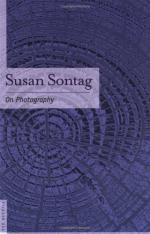|
This section contains 987 words (approx. 3 pages at 400 words per page) |

|
Daguerreotype / Calotype / Photograph
A daguerreotype is a photographic image produced by a methodology pioneered by Daguerre. In a daguerreotype, the image is exposed directly onto a polished surface of silver coated with a chemical. The mirrored surface is a negative but its reflection appears as a positive. Daguerreotypes can not easily be duplicated and they are fragile—historically, they were typically cased in glass for protection.
A calotype is a photographic image produced by a methodology pioneered by Fox Talbot. In a calotype, the image is exposed onto paper coated with a chemical. Several steps are used to stabilize and accentuate the chemical coating, resulting in a photograph. Calotypes are usually produced from negatives—they are robust, easy to duplicate from the same negative, and formed the basis for most modern chemical photographic processes.
A photograph is an image usually created by light interacting with a...
|
This section contains 987 words (approx. 3 pages at 400 words per page) |

|




